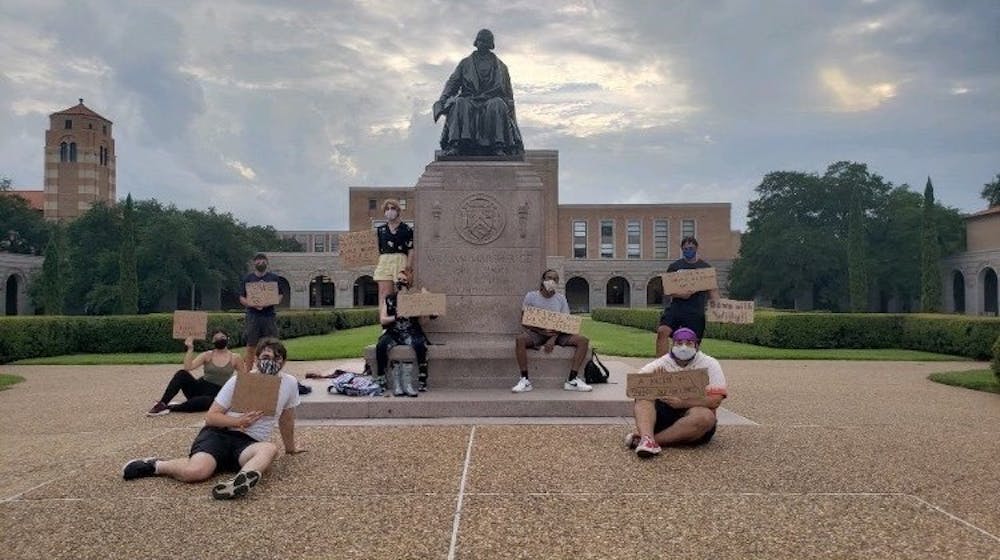Enough Deliberation: Down With Willy

At sit-ins during the fall semester, fellow protestors and I would occasionally be confronted by passersby defending William Marsh Rice’s legacy and his statue’s placement on our campus. Some may attribute the stubbornness of Willy’s defenders to the gaps in the record of William Marsh Rice’s ties to slavery. However, as more information about William Marsh Rice's life comes to light, this ignorance becomes a choice. Decision-makers and opponents of the sit-in alike must come to terms with the overwhelming evidence of the Rice family’s anti-Blackness and take down the statue.
Members of the Rice community — those involved in the Task Force on Slavery, Segregation and Racial Justice, as well as other researchers — are working to uncover information about Rice’s past and the people who shaped it. Last semester, I conducted research via HIST 535 (a seminar taught by task force co-chair and professor Caleb McDaniel, aided by the archivists at the Woodson Center and my classmates) on William Marsh Rice’s younger brother and business partner, Frederick Allyn Rice, and the pair’s connections to slavery. It was through this research that I learned that William Marsh Rice was even more heavily involved with the plantation system of labor, and the abuses and indignities it imposed on enslaved Black people, than even his harshest critics have claimed.
Existing research on our university’s namesake establishes him as an enslaver of at least 15 people, among other anti-Black actions. Nonetheless, it also separates William Marsh Rice from the plantation system. “William Marsh Rice and His Institute” concludes that William Marsh Rice “was too shrewd to go into cotton raising himself, subject as it was to the endless uncertainties of labor, soil conditions, unstable markets, and the weather.” However, records that I resurfaced bring Rice’s founder and namesake even closer to life at an enslaved labor camp, deepening the extent of William’s ties to slavery and bolstering the need to immediately bring down his statue.
William moved to Texas in 1837 and quickly became a cotton merchant and slaveowner. In 1854, his brother and partner Frederick took charge of Edge Hill cotton plantation and in 1855 listed 35 enslaved men, women and children as human property of the estate William himself was also directly involved in the affairs of Edge Hill, as he and Frederick both profited off the cotton cultivated by the enslaved people of the labor camp and sold by William’s eponymous firm (in which Frederick was a partner) — 118 bales of Edge Hill cotton were sold in this manner from late 1859 to early 1860 alone. Far from being “too shrewd” to get entangled with a cotton plantation, William sold Frederick’s cotton & concerned about hyper-specific management issues at Edge Hill. These records connect William Marsh Rice to plantation slavery more closely than ever before, a development that cannot be minimized, making his statue’s placement at Rice University all the more unacceptable.
It is imperative to place the enslaved people that picked and processed the cotton that filled the Rice bales at the center of the story. The 50 Black people enslaved by the Rice brothers (at least, this is a conservative estimate) are the real founders of Rice University. Learn their names. Research their lives. And honor their memories by working to decolonize Rice University. The fortune underlying its endowment was partly accumulated through their blood, sweat and tears. The products of their unpaid labor and their stolen wages, taken with the many more Black people exploited and utilized as capital in the Rice brothers’ various business dealings, were key to William Marsh Rice being able to create the Rice Institute and bar Black students from attending the same. To continue to literally place William Marsh Rice on a pedestal honors his legacy of enslaving, exploiting and excluding Black people.
We now know more than ever before about the depth of Rice’s ties to slavery. Still, we have much more to learn about the Rice family’s ties to anti-Blackness, and it is certain that further investigation will only deepen the urgency of recognition, reflection and reparation. Research into Frederick Allyn Rice’s sons, early members of the board of the Rice Institute and residents of Edge Hill Plantation, will likely reap more stories of anti-Blackness. Yet careful study of the past is not enough: Rice must change its approach in the present. Black students have offered the public and administration alike a tangible list of demands to work towards this goal. While taking down Willy’s statue has drawn the most attention, it is important that long-term demands like decolonizing Rice’s curriculum, increasing Black students’ presence and working to repair Rice’s relationship with Houston’s Black community be addressed as well. Rice University was born out of anti-Blackness, and understanding this history necessitates action. It is not too late to heed the demands of Black students and begin to reconcile our university’s legacy.
More from The Rice Thresher
This moment may be unprecedented — Rice falling short is not
In many ways, the current landscape of American higher education is unprecedented. Sweeping cuts to federal research funding, overt government efforts to control academic departments and censor campus protests and arbitrary arrests and visa revocations have rightly been criticized as ushering in the latest iteration of fascism.
This moment may be unprecedented — Rice falling short is not
In many ways, the current landscape of American higher education is unprecedented. Sweeping cuts to federal research funding, overt government efforts to control academic departments and censor campus protests and arbitrary arrests and visa revocations have rightly been criticized as ushering in the latest iteration of fascism.
Obituary for D’Brickashaw Eagleclaw Ibarra
D’Brickashaw Eagleclaw Ibarra, nicknamed DEI, has transitioned to the ancestral plane.


Please note All comments are eligible for publication by The Rice Thresher.